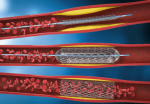In ST elevation ACS the preferred treatment is primary PCI. However, one its limitations is thrombus presence and its distal embolization, which threatens microcirculation perfusion and is therefore associated to ventricular function deterioration and bad evolution. Manual thrombus aspiration has been tested in different studies but the problem remains unsolved; mechanical thrombectomy might be a...
POKI: A New Bifurcations Strategy
This scientific article we briefly discuss the POKI technique, a new stent optimization strategy for bifurcation lesions. Coronary bifurcations represent 20 to 25% of percutaneous coronary interventions (PCI) and continue to be a real challenge at present; the different available treatment strategies are used to correct bifurcation carina after stenting seeing as incomplete strut apposition...
Intervention in Patients with Takayasu Arteritis: Rescue Therapy or an Alternative Complementary to Immunosuppressive Therapy?
Takayasu arteritis (TAK) is an uncommon granulomatous large-vessel vasculitis that affects the aorta and its primary branches. The most frequently types of observed vascular compromise are obstructive lesions, and aneurysmal vascular lesions or dissections. In 2021, the American College of Rheumatology recommended not to implement percutaneous intervention (PI) with these patients and only use immunosuppressive...
The Most Important Articles of 2022 in Coronary disease
Discover the most important scientific articles of 2022on coronary disease in our website. An Abbreviated Dual Antiplatelet Regimen Is Also Safe in Patients at High Risk for Bleeding Undergoing Complex Angioplasty The MASTER DAPT study analyzed the results of an abbreviated (mean 34 days) vs. conventional dual antiplatelet therapy (DAPT) in 4579 patients treated with angioplasty and a biodegradable polymer sirolimus-eluting stent....
Aspiration Thrombectomy in Acute Coronary Syndrome: Is the Japanese Perspective a Strategy to Emulate?
Aspiration thrombectomy (AT) in patients with high thrombotic burden could pathophysiologically reduce thrombus burden, decrease distal embolization, reduce no-reflow phenomenon, and improve microvascular perfusion. However, its usefulness has not been shown in the large, randomized trials (TASTE and TOTAL) that compared routine use of AT in primary angioplasty in patients with ST-segment elevation acute coronary...
Longitudinal Deformation of a Stent with the POT Technique
The fractal geometry of coronary bifurcations offers a mismatch between the proximal diameter of the main branch and the distal branches that make up the bifurcation. Angioplasty in this area can be performed through different techniques depending on plaque distribution, and the particular geometry of each bifurcation. Overall, and regardless of the strategy used, there...
Three-Year Outcomes after CTA with 2-Stent Technique Vs. Provisional Stenting for Complex Bifurcation Lesions
The prevalence of coronary lesions with bifurcation involvement is about 20% in patients undergoing coronary angiography (CTA). While provisional stenting is overall the most accepted technique, the 2018 myocardial revascularization guidelines recommend the 2-stent technique for complex bifurcation lesions, defined as side branch with lesion >5mm, distal reference diameter of the side branch ≥2.75, or...
PCI on Native Arteries or Saphenous Vein Grafts: Which Has Better Prognosis?
New revascularization after coronary artery bypass graft (CABG) is often needed, be it because of severe bridge lesion, intimal hyperplasia, thrombosis, atherosclerosis, or native vessel lesion progression. We therefore need to determine the best revascularization strategy, namely native or graft percutaneous intervention, venous or arterial, or repeat surgery, with the risk it entails. There is...
SOLACI PERIPHERAL | 7th Clinical Case: Percutaneous Treatment for Nutcracker Syndrome
New SOLACI PERIPHERAL clinical case to keep learning among peers! Dr. Carlos Eduardo Díniz Couto shares a “Nutcracker” case from Belo Horizonte, Brazil. This is the 7th clinical case presented by SOLACI Peripheral on the SOLACI website. This space is intended to further promote and share experiences and opinions in order to continue improving our...
TCT 2020 | Our Next Goal Should Be Using IVUS Guidance in Every Angioplasty
The benefits of intravascular ultrasound (IVUS) guidance in all angioplasties with second-generation drug-eluting stents (DES) persist through 3 years of follow-up. These data derive from the extended follow-up of the ULTIMATE study, presented virtually at TCT 2020 and published simultaneously in JACC Intv. At 3 years, target-vessel failure remained lower in patients whose angioplasty was guided by...









